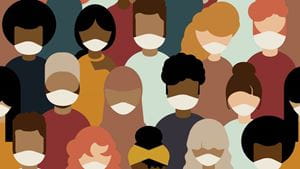
People of color are among the hardest hit by the COVID-19 pandemic. According to data from the Centers for Disease Control and Prevention (CDC), Black or African American persons are 3.7 times more likely to be hospitalized by COVID-19 than White persons and 2.8 times more likely to die from the disease. Hispanic or Latinx persons are 4.1 times more likely to be hospitalized and 2.8 times more likely to die.
“We’ve known for many years that diseases such as diabetes, hypertension, obesity, and asthma are disproportionately affecting people of color, particularly African Americans and Latinx,” said Deborah Stamps, Ed.D., Executive Vice President, Chief Nursing Education and Diversity Officer. “Unfortunately, when you look at the predisposing conditions that lead to a bad outcome with COVID-19, they are just those very comorbidities.”
The currently available COVID-19 vaccines have shown to be over 94% effective in clinical trials and have not shown to be harmful or result in serious side effects for any specific race or ethnicity.
Many Black and Latinx communities have lacked equal access to healthcare throughout American history. Today, those communities face the highest COVID-19 rates. They are also the least likely to get the COVID-19 vaccine, according to a survey by the National COVID Cohort Collaborative.
The survey found that less than half of Black adults said they would “definitely” or “probably” get coronavirus vaccines if there was no cost, and only 18% said they would “definitely” get vaccinated regardless of the cost.
Only 14% of Black adults and 34% of Latinx adults said they trust vaccine safety, and three-quarters of both Black and Latinx respondents said they are less likely to get a vaccine that’s approved for emergency use by the Food and Drug Administration.
“We can trust the scientists who have studied the coronavirus for more than 20 years,” Stamps said. “There have been many monitors put in place to ensure vaccine efficacy and safety such as the FDA, CDC, the Veterans Affairs, Department of Defenses, and the Indian Health Services. For the first time, the African American and Latinx communities are at the front of the line to receive equitable treatment.”
While COVID-19 is a new disease, coronavirus is not. In fact, there are many different coronaviruses that exist, and scientists have been studying coronaviruses for more than 50 years. In January 2020, about ten days after the first reported case of the new coronavirus in Wuhan, China, scientists went back to all of those years of research as a starting point and uncovered the viral sequence of COVID-19.
The newly approved COVID-19 vaccines from Pfizer/BioNTech and Moderna use a small amount of genetic material that teaches cells to make the “spike” protein that’s found in the virus (shaped like spikes when viewed under a microscope). Once cells begin copying the spike protein, the immune system starts to learn how to defend against the virus.
Scientists were especially interested in messenger RNA vaccines (mRNA) because they can be made with readily available materials and don’t require the use of a live virus. This makes it easier to standardize and manufacture large quantities of a vaccine and has contributed to the quick and safe manufacturing and approval of the COVID-19 vaccines.
The CDC recently revised its COVID-19 vaccination guidelines designed to help states, territories, and local health officials develop plans for distributing vaccines. It now suggests plans should be made by local jurisdictions to ensure equitable access to vaccinations and lists racial and ethnic groups as critical populations that may be at an increased risk of getting the virus.
“We have an opportunity to address health disparities and health equity for all through the COVID-19 vaccine,” said Stamps. “The spread of COVID-19 exemplified some of the health disparities that already exist in our communities and have been around for a long time, and I think that now is an opportunity for us to step up and participate, be engaged, and be leaders in really eradicating this virus moving forward.”
Federal and state governments have established a permanent vaccine site at the former Kodak Hawkeye parking lot at 1345 St. Paul St., Rochester.
The site ensures that communities of color and other residents from disadvantaged neighborhoods who have been at the back of the line for vaccines will be first in line at this site. This clinic is not operated by Rochester Regional Health, but we encourage those eligible to take advantage of the opportunity to get vaccinated.
Appointments are required and scheduling is now available on the NYS “Am I Eligible” site or via the New York State COVID-19 Hotline: 1-833-NYS-4-VAX (1-833-697-4829).
For information on eligibility and appointments, visit https://covid19vaccine.health.ny.gov/phased-distribution-vaccine.